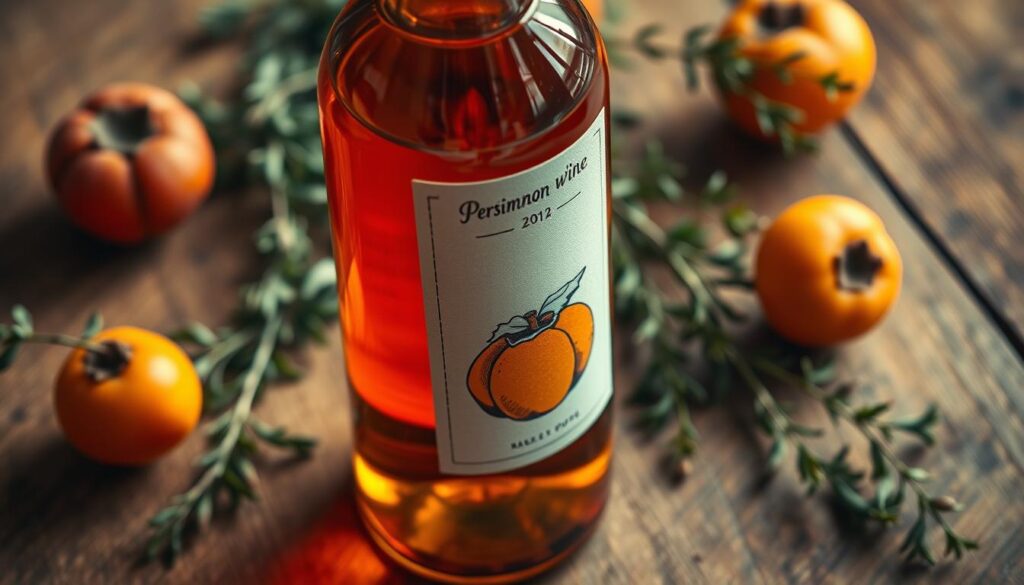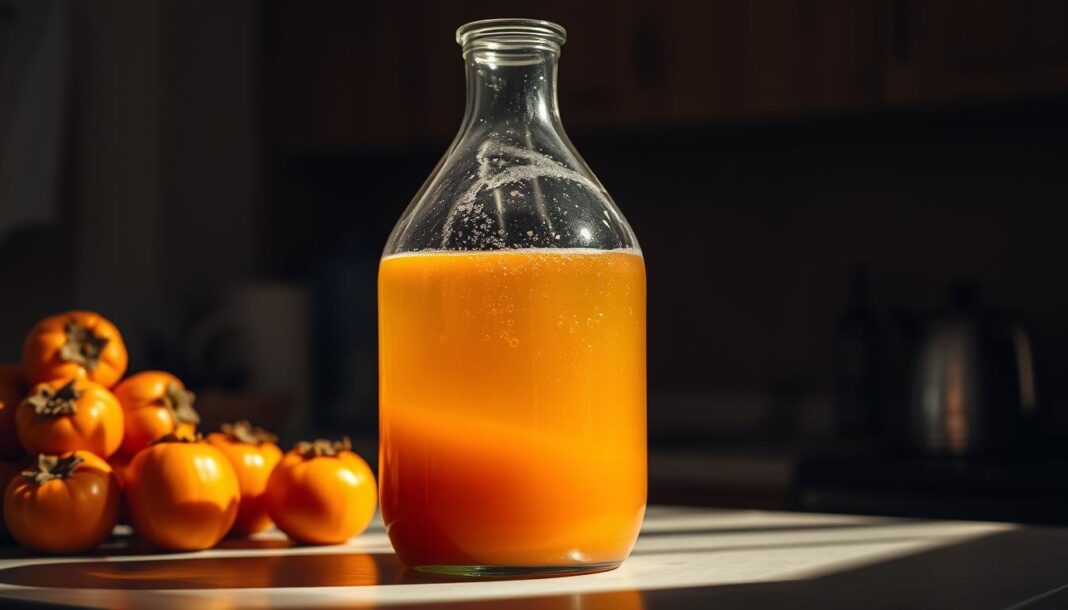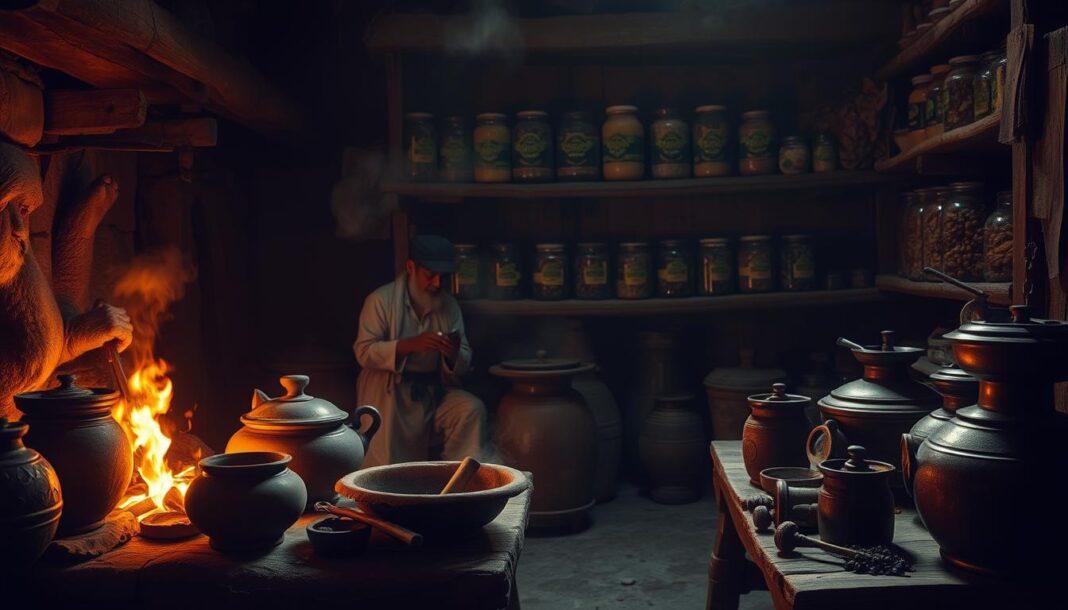At Historical Foods, we’re excited to share the art of crafting delicious persimmon wine at home. Persimmons, with their sweet and tangy flavor, make an excellent base for homemade wine. With a rich history in Korean cuisine and culture, persimmon wine is a unique and rewarding beverage to produce.
The winemaking process, which takes approximately 4-6 months, involves careful attention to fermentation and patience. As you work through each batch, you’ll gain a deeper understanding of the intricacies involved in creating this delightful drink. For a detailed guide on the process, visit our comprehensive resource on persimmon wine.
Key Takeaways
- Persimmons are an excellent fruit for making homemade wine due to their sweet and tangy flavor.
- The winemaking process takes approximately 4-6 months from start to finish.
- Understanding the fermentation process is crucial for successful winemaking.
- Persimmon wine has a rich history and significance in Korean cuisine and culture.
- Patience is key to producing high-quality persimmon wine.
Understanding Persimmons for Wine Making
The journey to crafting exceptional persimmon wine starts with understanding persimmons. Persimmons are a versatile fruit that can be used to create a variety of wines, but the type of persimmon used can significantly impact the flavor and quality of the final product.
Types of Persimmons Suitable for Wine
There are several varieties of persimmons, but two main categories are predominantly used for winemaking: Fuyu and Hachiya.
Fuyu (Sweet) Persimmons
Fuyu persimmons, also known as Dan Gam or “sweet persimmons,” have a tomato-like shape and can be used when still firm, making them easier to work with for wine production. Their sweetness and texture make them an ideal choice for creating a smooth and palatable wine.
Hachiya Persimmons
Hachiya persimmons, or Ddulben Gam, are more astringent when unripe due to high tannin levels but offer complex flavors when fully ripened. They are longer and usually larger than Fuyu persimmons and require careful handling to avoid bitterness.
Selecting and Preparing Persimmons
Selecting perfectly ripe persimmons is crucial for optimal sweetness and flavor. Persimmons are among the sweetest fruits in the world when properly ripened. Proper preparation techniques, including washing, peeling, seeding, and cutting the fruits into appropriate sizes for fermentation, are essential. It’s also important to avoid over-processing persimmons to prevent extracting bitter compounds from seeds and skins.
| Persimmon Type | Characteristics | Usage in Wine Making |
|---|---|---|
| Fuyu | Sweet, tomato-like shape, firm texture | Easy to work with, sweet flavor |
| Hachiya | Astringent when unripe, complex flavors when ripe | Requires careful handling, complex flavor profile |
For a detailed persimmon wine recipe, you can visit this page for more information.

Essential Equipment and Ingredients for Persimmon Wine
Before diving into the world of persimmon wine making, it’s crucial to understand what equipment and ingredients are required. Having the right tools and materials is fundamental to producing high-quality wine.
Required Fermentation Equipment
For primary fermentation, you’ll need a food-safe, non-reactive container such as a ceramic crock, glass carboy, or stainless steel pot with a lid. This vessel should be capable of holding one-quarter to one-half more volume than your total liquid to accommodate the fermentation cap. For secondary fermentation, you’ll need a vessel with a narrow neck that can be sealed with an airlock, such as a demi-john or carboy.
Ingredients List and Measurements
Basic Ingredients
The basic ingredients for making persimmon wine include persimmons, granulated sugar, acid blend for pH adjustment, water, and specialized wine additives like pectic enzyme and yeast nutrient. The typical measurements are: 2-3 lbs persimmons, 1-2 lbs sugar, 1 tsp acid blend, 1 gallon water, 1 tsp pectic enzyme, and 1 tsp yeast nutrient.
Optional Additives and Their Purpose
Optional additives include wine yeast (such as Montrachet or Champagne yeast) for fermentation, yeast nutrient to support healthy fermentation, and potassium sorbate for stabilization. Wine tannin can be added to balance the flavor. The typical dosage is 1 tsp of yeast nutrient and 1/2 tsp of wine tannin.
Sanitization Importance
Proper sanitization of all equipment is critical to prevent contamination. Use a solution like crushed Campden tablets (one tablet per quart of water) to sanitize your equipment.
How to Make Persimmon Wine: Step-by-Step Process
Making persimmon wine at home is a rewarding experience that involves a series of straightforward steps. We will guide you through the process, from preparing the fruit to the final stages of clearing and stabilizing your homemade wine.
Preparing the Fruit and Primary Fermentation
The initial step involves preparing the persimmons for fermentation. Start by mashing the persimmons well using a serving fork or potato masher, then place them in the primary vessel. To the pulp, add acid blend, yeast nutrient, a crushed Campden tablet, and half of the sugar. Mix in a gallon of water and stir until the sugar is fully dissolved. Let the mixture rest, covered, for half a day.
After 12 hours, add pectic enzyme and wine yeast to the mixture. Allow it to ferment for five to seven days, stirring daily and keeping the vessel covered. This primary fermentation phase is crucial for developing the wine’s flavor and character.
Extracting Juice from Persimmons
The process begins with extracting juice from the persimmons. By mashing the fruit, you release its natural juices, which will eventually become the base of your wine.
Starting the Fermentation Process
With the persimmon pulp and initial ingredients mixed, the fermentation process begins. It’s essential to stir daily during the primary fermentation phase to ensure even extraction of flavors and to prevent spoilage.
Secondary Fermentation and Racking
After seven days, strain the liquid through a nylon sieve into another container, discarding the solids. Rinse the primary vessel, return the liquid to it, and add the remaining half of the sugar, stirring well. Transfer the liquid to a secondary container with at least 3 inches of headroom, and fit it with an airlock.
Monitor the fermentation progress over the next three to four weeks. You’ll notice bubbles in the airlock and a gradual slowing of fermentation activity.
Transferring to Secondary Vessel
Transferring the wine to a secondary vessel is a critical step that helps clarify and mature the wine. Ensure the new vessel is clean and has enough headroom.
Monitoring Fermentation Progress
Keep an eye on the airlock for signs of fermentation activity. As the bubbles slow, it indicates that the fermentation is progressing as expected.
Clearing and Stabilizing Your Wine
After three to four weeks, it’s time to rack (siphon) the wine into a clean secondary vessel, leaving behind any sediment. Repeat this process every month until the wine is clear and stable, typically after about three months. This step is crucial for achieving a clear, high-quality wine.
By following these steps and being patient, you’ll end up with a delicious homemade persimmon wine that’s perfect for sipping on special occasions or sharing with friends.
Bottling, Aging and Enjoying Your Homemade Persimmon Wine
As we conclude our journey through the process of making persimmon wine, it’s time to focus on the final stages that will elevate your homemade wine to perfection.
Proper bottling is crucial for preserving the quality of your persimmon wine. For small batches, it’s simplest to bottle in flip-top Grolsch bottles, but for larger batches, we recommend using traditional wine bottles and corks for better results. Before transferring the wine, make sure to sanitize your bottles thoroughly to prevent contamination.
If you prefer a sweeter wine, you can add more sugar along with a wine stabilizer like potassium sorbate to prevent refermentation. Remember not to add more than 1/2 teaspoon of stabilizer per gallon of wine.
Aging is a critical step that allows the flavors to mature. We recommend a minimum aging period of 1 month, but ideally 3-4 months for optimal flavor development. Store your bottles in a cool, dark place, and once aged, chill and serve your persimmon wine in a tall flute to appreciate its unique characteristics.
Your homemade persimmon wine makes an excellent gift, especially when presented with the story of its creation. Feel free to experiment with your own variations of persimmon wine recipes, perhaps by adding complementary spices or blending with other fruit wines. Thanks to your patience and dedication, you’ll be able to enjoy your very own persimmon wine for months to come.


